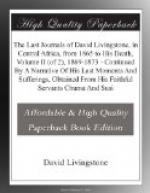Subsequently to the period of gigantic volcanic action, the outflow of fresh lime-water from the bowels of the earth seems to have been extremely large. The land now so dry that one might wander in various directions (especially westwards, to the Kalahari), and perish for lack of the precious fluid as certainly as if he were in the interior of Australia, was once bisected in all directions by flowing streams and great rivers, whose course was mainly to the south. These river beds are still called by the natives “melapo” in the south, but in the north “wadys,” both words meaning the same thing, “river beds in which no water ever now flows.” To feed these a vast number of gushing fountains poured forth for ages a perennial supply. When the eye of the fountain is seen it is an oval or oblong orifice, the lower portion distinctly water worn, and there, by diminished size, showing that as ages elapsed the smaller water supply had a manifestly lesser erosive power. In the sides of the mountain Amhan, already mentioned, good specimens of these water-worn orifices still exist, and are inhabited by swarms of bees, whose hives are quite protected from robbers by the hardness of the basaltic rocks. The points on which the streams of water fell are hollowed by its action, and the space around which the water splashed is covered by calcareous tufa, deposited there by the evaporation of the sun.
Another good specimen of the ancient fountains is in a cave near Kolobeng, called “Lepelole,” a word by which the natives there sometimes designate the sea. The wearing power of the primeval waters is here easily traced in two branches—the upper or more ancient ending in the characteristic oval orifice, in which I deposited a Father Mathew’s leaden temperance token: the lower branch is much the largest, as that by which the greatest amount of water flowed for a much longer period than the other. The cave Lepelole was believed to be haunted, and no one dared to enter till I explored it as a relief from more serious labour. The entrance is some eight or more feet high, and five or six wide, in reddish grey sandstone rock, containing in its substance banks of well rounded shingle. The whole range, with many of the adjacent hills on the south, bear evidence of the scorching to which the contiguity of the lava subjected them. In the hardening process the silica was sometimes sweated out of this rock, and it exists now as pretty efflorescences of well-shaped crystals. But not only does this range, which stands eight or ten miles north of Kolobeng, exhibit the effects of igneous action, it shows on its eastern slope the effects of flowing water, in a large pot-hole called Loee, which has the reputation of having given exit to all the animals in South Africa, and also to the first progenitors of the whole Bechuana race. Their footsteps attest the truth of this belief. I was profane enough to be sceptical, because the large footstep of the first man Matsieng was directed as if going into instead of out of this famous pot-hole. Other huge pot-holes are met with all over the country, and at heights on the slopes of the mountains far above the levels of the ancient rivers.




